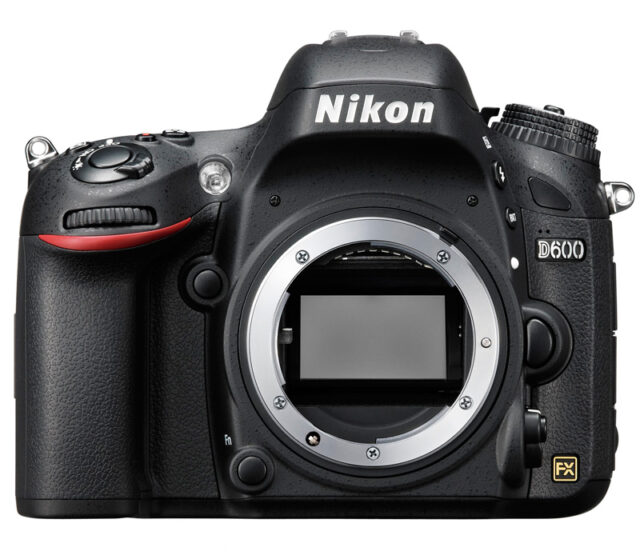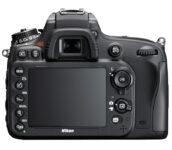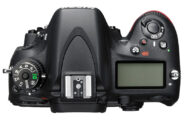Announced
Production status
System
Nikon F system cameras
- Nikkorex F
- Nikkormat EL
- Nikkormat ELW
- Nikkormat FS
- Nikkormat FT
- Nikkormat FT2
- Nikkormat FT3
- Nikkormat FTN
- Nikon D3
- Nikon D3s
- Nikon D3X
- Nikon D4
- Nikon D4s
- Nikon D5
- Nikon D6
- Nikon D600
- Nikon D610
- Nikon D700
- Nikon D750
- Nikon D780
- Nikon D800
- Nikon D800E
- Nikon D810
- Nikon D850
- Nikon Df
- Nikon EL2
- Nikon EM
- Nikon F
- Nikon F100
- Nikon F2
- Nikon F3
- Nikon F4
- Nikon F5
- Nikon F6
- Nikon FA
- Nikon FE
- Nikon FE10
- Nikon FE2
- Nikon FG
- Nikon FG-20
- Nikon FM
- Nikon FM10
- Nikon FM2
- Nikon FM2/T
- Nikon FM3A
- Nikon N2000
- Nikon N2020
- Nikon N4004
- Nikon N4004S
- Nikon N50
- Nikon N5005
- Nikon N55
- Nikon N60
- Nikon N6000
- Nikon N6006
- Nikon N65
- Nikon N70
- Nikon N75
- Nikon N80
- Nikon N8008
- Nikon N8008S
- Nikon N90
- Nikon N90S
Nikon D600
35mm AF digital SLR camera • Discontinued
Specification
| Format: | |
| 35mm full frame | |
Imaging sensor: | 35.9 × 24mm CMOS sensor |
Resolution: | 6016 × 4016 - 24 MP |
Sensor-shift image stabilization: | - |
| Nikon F [46.5mm] | |
| Shutter: | |
Type: | Focal-plane |
Model: | Electronically controlled |
Speeds: | 30 - 1/4000 + B |
| Exposure: | |
Exposure metering: | Through-the-lens (TTL), open-aperture |
Exposure modes: | Programmed Auto |
| Aperture-priority Auto | |
| Shutter-priority Auto | |
| Manual | |
| Physical characteristics: | |
Weight: | 850g |
Dimensions: | 141x113x82mm |
Manufacturer description
TOKYO - Nikon Corporation is pleased to announce the release of the Nikon D600. Despite having the smallest and lightest body among Nikon FX-format cameras, the D600 offers advanced basic camera performance, and is equipped with a new FX-format CMOS image sensor with an effective pixel count of 24.3-million pixels and the same EXPEED 3 image-processing engine built into high-end Nikon D-SLRs (D4, D800, D800E) for superior definition and image quality.
The D600 is a new model added to the Nikon FX-format digital SLR lineup with a smaller size and lighter weight–approx. 141 (W) x 113 (H) x 82 (D) mm, 760 g*1 for excellent portability, yet offers the superior image quality and rendering performance, operation, and durability of high-end FX-format D-SLRs. The D600 is a compact and lightweight camera that offers excellent cost performance. In addition to a new FX-format CMOS image sensor with an effective pixel count of 24.3-million pixels and the same EXPEED 3 image-processing engine built into high-end models, the D600 inherits a number of advanced features from its high-end cousins, including an optical viewfinder with frame coverage of 100%*2, a large and clear, 3.2-inch LCD monitor with a wide viewing angle for superior visibility, and the same dust- and water-resistance as the D800 and D800E. What's more, this single FX-format camera also offers support for the complete DX NIKKOR lens lineup for greater convenience with both still image shooting and movie recording. The D600 makes full use of its 24.3-million effective pixels with high-resolution, full-HD movie recording (1920 x 1080/30p). It is also equipped with the Multi-area mode Full-HD D-Movie function, which enables recording in either FX- or DX-based movie format for more creative imaging expression.
D600 Development Background
Nikon has been strengthening and expanding its FX-format digital SLR camera lineup, most recently with the release of the D4, the new FX-format flagship model that offers the ultimate in functions and performance, followed by the D800 and D800E, both equipped with a CMOS image sensor with an effective pixel count of 36.3-million pixels, for incredible definition and image quality. The D600 was developed to bring the enjoyment of photography with an FX-format camera to a broader range of users. It offers the superior rendering characteristics, image quality, operation, and durability of previous FX-format D-SLRs in a body that is as compact, lightweight, and easy to use as DX-format cameras, thus making it suited not only to advanced amateur and professional photographers, but also photo enthusiasts looking to make the most of their more creative side.
D600 primary features
1. The Nikon FX format in a compact and lightweight body for excellent portability
The D600 measures approximately 141.0 x 113.0 x 82.0 mm (W x H x D) and weights approximately 760 g*, making it extremely compact and the lightest Nikon FX-format digital SLR camera available. In addition to adoption of a lightweight and durable magnesium alloy for the top and rear body covers, all joints are effectively sealed for the same superior dust- and water-resistance as the D800 and D800E.
2. A new 24.3-megapixel FX-format CMOS image sensor for superior image quality and resolution over a broad range of sensitivities
The D600 is equipped with a new FX-format CMOS image sensor with an effective pixel count of 24.3-million pixels that ensures a high signal-to-noise ratio and broad dynamic range. The camera supports a broad range of standard sensitivities, from ISO 100 to ISO 6400, for beautiful images exhibiting very little noise and rich expression of tones. The range of sensitivities can also be expanded to the equivalent of ISO 50 (Lo 1) or up to the ISO 25600 equivalent (Hi 2). What's more, use of NIKKOR lenses equipped with Nikon's advanced optical technologies maximizes performance of the D600's FX-format CMOS sensor, with its effective pixel count of 24.3-million pixels, for images that offer clear and sharp reproduction of even the finest details.
3. The EXPEED 3 image-processing engine, optimized for high-performance digital SLR cameras like the D600, for superior, high-speed processing
The D600 is equipped with the same EXPEED 3 high-speed image-processing engine built into high-end D4, D800, and D800E Nikon FX-format cameras. The EXPEED 3 image-processing engine has been optimized for digital SLR cameras to offer faster and better performance for faithful rendering, vivid color reproduction, and expression of a broad dynamic range. It also effectively suppresses noise with advanced noise-reduction processing for still images captured at high sensitivities under dim lighting, all while preserving definition and sharpness. Special noise-reduction processing designed especially for movies maintains crisp, clear outlines in movies recorded in low-light situations.
4. Excellent basic camera performance and operation for comfortable shooting
Adoption of the Multi-CAM4800 autofocus sensor module enables certain acquisition and tracking of the intended subject with 39 focus points. Cross-type sensors have been adopted for the nine most frequently used focus points at the center of the frame. In addition, seven focus points (5 horizontal focus points and 1 each above and below at the center of the frame) are fully functional at f/8. All of this means more precise autofocusing when super-telephoto NIKKOR lenses are used with a teleconverter (2.0x).
What's more, extremely precise automatic control provided by the Scene Recognition System analyzes detailed scene brightness and color information acquired from the 2,016-pixel RGB sensor, and applies that information to autofocus, automatic exposure, i-TTL balanced fill-flash, and white balance control.
The D600 is also equipped with a high-magnification optical viewfinder that supports a frame coverage of approximately 100% with shooting in FX format and magnification of approximately 0.7x*1. The 3.2-inch, approximately 921k-dot monitor with wide viewing angle is equipped with an ambient brightness sensor that automatically controls monitor brightness and contrast according to ambient lighting conditions to ensure clear viewing. Dual SD memory card slots (SDXC, UHS-I2 compliant) that enable the use of two SD memory cards at a time make for smoother, stress-free still-image and movie recording.
5. High-resolution, full-HD movie recording at 1920 x 1080/30p making full use of a high effective pixel count of 24.3-million pixels, and Multi-area mode Full-HD D-Movie for recording movies in one of two formats
By simply pressing the movie-record button just above and to the left of the shutter-release button in movie live view mode, users can enjoy movie recording that makes full use of the camera's 24.3-million effective pixels. Not only does the D600 support full-HD movie recording at 1920 x 1080/30p, but adoption of the H.264/MPEG-4 AVC video compression standard ensures that superior picture quality is maintained while data is compressed to allow for recording of a single movie for up to 29 minutes and 59 seconds*1.
The Multi-area mode Full-HD D-Movie function offers two movie formats*2, FX-based movie format and DX-based movie format, for recording of full-HD 1920 x 1080/30p. (both FX- and DX lenses can be used). The FX-based movie format makes full use of the large image sensor and offers a shallow depth-of-field with an emphasis on blur characteristics while the DX-based movie format is optimal for recording movies that bring subjects closer when lenses with short focal lengths are used.
The D600 is also equipped with a headphone jack so that headphones may be used to check sound, and movies and the movie live view display can be viewed simultaneously in the camera's monitor and an external monitor. Uncompressed movie data recorded in movie live view mode can also be output to an external recorder via the built-in HDMI interface, and the time-lapse photography function can be used to automatically photograph relatively slow moving action, such as the blooming of a flower and the passing of clouds, at specified intervals. The camera then combines the photos and records them as a silent time-lapse movie.
6. Support for the Wireless Mobile Adapter WU-1b for collaboration with smart devices
When the Wireless Mobile Adapter WU-1b (sold separately) is connected, true, high-quality photos captured with a compatible digital SLR camera can be easily transferred to a smart device*1 for sharing of images. The smart device can be used to control camera shooting remotely with the live view display shown in the smart device screen, and images captured with the D600 can be transferred to the smart device over a wireless network connection*2 (remote movie recording is not supported). The WU-1b allows for the immediate transfer of photos captured with the D600 and NIKKOR lenses to family and friends, or uploading to blogs or social networking sites, increasing the ways users enjoy their photos after they are taken.
Additional D600 Features and Functions
- Extremely fast response with high-speed continuous shooting at approximately 5.5 fps*, a power-up time of approximately 0.13 s*, and a shutter-release time lag of approximately 0.052 s*, as well as a virtual horizon feature showing not only horizontal tilt to the left or right (roll), but also forward and backward tilt (pitch; only the roll indicator is displayed in the viewfinder).
- Equipped with a built-in flash that covers the angle of view of a wide-angle 24-mm lens and has a guide number of approximately 12/39 (m/ft, ISO 100, 20°C/68°F). The built-in commander function enables wireless control over up to two groups of remote optional flash units with the built-in flash serving as the master flash.
- New Multi-Power Battery Pack MB-D14 (sold separately), which holds not only Rechargeable Li-ion Batteries EN-EL15, but also AA batteries (alkaline, lithium, Ni-MH) is available.
- A durable shutter unit that has passed testing for approximately 150,000 cycles, and supports a maximum shutter speed of 1/4000 s and flash sync speed of 1/200 s. The shutter is equipped with a monitor function that automatically checks for, and detects, errors between the specified shutter speed and actual shutter speed.
- A locking mechanism on the mode dial prevents accidental adjustment of the shooting. Operation has also been improved by positioning the mode dial on top of the release mode dial.
- Independent Picture Control and movie-record buttons make the camera easier to operate.
- A live view selector makes live view operation more convenient with smooth switching between live view photography and movie live view.
- Nikon's image browsing and editing software, ViewNX 2, is supplied with purchase.
Similar cameras (2)
35mm full frame • Auto focus • Digital • Singe-lens reflex • Nikon F mount
| Model | Shutter | Metering | Modes | Year |
|---|---|---|---|---|
| Kodak DCS Pro 14n | E, 1/4000 | TTL • OA | PASM | 2002 ● |
| Kodak DCS Pro SLR/n | E, 1/4000 | TTL • OA | PASM | 2004 ● |


